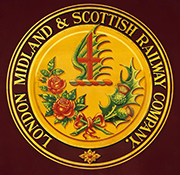

This site uses non-intrusive cookies to enable us to provide a better user experience for our visitors. No personal information is collected or stored from these cookies. The Society's policy is fully explained here. By continuing to use this site you are agreeing to the use of cookies.
From this brief description of the L.M.S. organisation, we may turn to its physical foundation, the track. To the layman observing the railway running lines, the track has remained unaltered for many years, but in fact, all the main track components-rails, chairs, sleepers and ballast, as well as the methods of manufacture and maintenance-have been entirely altered during the lifetime of the L.M.S. Before the war train speeds and weights were increased considerably, and the track of 1923 could not have stood the stress of later years when 6,900 miles a day were run by trains travelling at 60 m.p.h, or over, start to stop.
The composition of the rails has been under continuous research, which has achieved greater reliability and a longer life. The standard rail length remains at 60 feet, but 120-feet rails have been in experimental use since 1937. When political changes reduced supplies of Baltic Redwood for sleepers, other timber, particularly Douglas Fir, was used. For this a new preservative treatment was studied and secured. With the war, supplies became short and home-grown woods had to be used. Creosote was in short supply and Wolman salts were tried with success to preserve the home-grown woods. Jointly with the Department of Scientific and Industrial Research and the company, research methods provided a design of pre-stressed reinforced concrete sleeper which stands up to main line traffic reasonably well, but reliance on wooden sleepers is still necessary.
Improvements in maintenance methods have proceeded step by step with improvements in materials and design of track components. The installation of transition curves gives increased comfort in high-speed trains and less lateral stresses on the track. For example, before the "Coronation Scot" could be run, 297 miles of track in its path had to be re-aligned to suit the increased speeds.
To make timely provision for the future, and its increasing demands on the track, experiments with flat bottom rails weighing 110 lbs. per yard began in 1936, five miles being laid at six different places. Careful records were taken of the time required to maintain the new track and adjacent lengths of standard track laid at the same time. Favourable results from these trials led to a further 12 miles being laid in 1939, and during the war experiments and research continued as far as possible. A new rail section weighing 113 lbs. per yard has now been designed with results which indicate that important economies in maintenance will follow.
Many other track improvements have been effected, such as the welding of switches and crossings in situ, thereby materially prolonging their lives; new creosoting methods; the mechanisation of material depots; the use of steel keys, in place of timber, which minimise rail creep; mechanised plant for unloading wagons; the reconditioning of worn fishplates to improve the joints of partly worn rails; the adoption of standard designs of rail, ballast and sleeper wagons; new designs, of locomotive water troughs which are easier to install and maintain and cause less wastage of water; the use of mobile maintenance gangs with motor trollies; the standardisation of fencing; and the adoption of "two level" junctions to enable the super-elevation to be carried right through the junction, with increased comfort in travel and relaxation of speed restrictions. At one main line junction the permissible speed of trains has by this means been increased from 30 to 55 m.p.h. with more comfortable riding. Seventy-six junctions have been remodelled thus, and in addition there are numerous "two level" connections off curved line.
Continuous attention has been given to improvements in structural design, materials and methods. The use of long roof spans has been developed, and a central bridge repair shop erected, where steelwork is fabricated ready for application by the repair gangs. Rapid progress has been made in the use of reinforced concrete, in both its pre-cast and in situ forms, with ordinary and pre-stressed reinforcement. Numerous reinforced concrete bridges, both over and under the track, have been erected, with economies in erection and maintenance, and reinforced concrete has also been largely used in minor structures.
Site contents Copyright © LMS Society, 2024

May 10th, 2024
Site contents Copyright © LMS Society, 2024